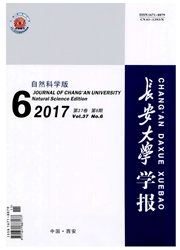

 中文摘要:
中文摘要:
当前隧道相关规范中提供的计算隧道上方土体对衬砌地震作用力的方法,仍采用静压力拱的高度来确定衬砌上方土体的地震作用高度,其准确性有待确定。本文采用解析计算与有限元计算对比分析的方法,通过研究隧道上方竖向应力在地震前后沿深度的变化,来确定隧道上方土体的地震作用高度Hp,给出了考虑隧道跨度、围岩级别、隧道结构形状及埋深等因素的隧道上方土体对衬砌地震作用高度的计算公式,确定了衬砌上的作用力,明确了其作用方式,并验证了其适用性。研究结果表明:解析计算和有限元计算所得结果沿隧道衬砌的分布规律一致;隧道埋深较小时,隧道规范计算出的Hp偏大;埋深较大时,隧道规范计算出的Hp偏小,采用该方法确定隧道上方土体地震作用高度Hp是可行的;衬砌上的作用力以切向力形式分布在衬砌的上半拱。研究结果可为隧道抗震计算及设计提供参考。
 英文摘要:
英文摘要:
The current calculation method of seismic force provided for soil above the tunnel lining was not accurate enough, which still used hydrostatic pressure arch height to determine the earthquake height of soil above the lining. Combined finite element method with analytical calculation, this paper defined the earthquake height Hp of soil above the tunnel by researching the change of vertical stress above the tunnel along depth before and after earthquake, gave out the formula for Hp considering tunnel span, rock types, shape and depth of the tunnel and many other factors, determined the forces acting on the lining, cleared its mode of action, and verified its applicability. The results show that the distribution of analytical calculation results is same to that of the results gained from finite element method. The f/p calculated by tunnel specification is bigger when the tunnel depth is small; on the other hand, the He calculated by tunnel specification is smaller when the tunnel depth is big. The method used to define Hp is feasible. The action mode on lining is distributed over half-arch lining provide a reference for seismic calculation of tunnel. 2 tabs, 13 figs, 22 refs.
 同期刊论文项目
同期刊论文项目
 同项目期刊论文
同项目期刊论文
 期刊信息
期刊信息
